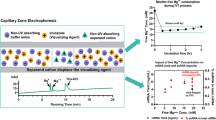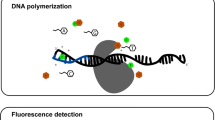Abstract
Current DNA extraction methods for parasites are labour-intensive and usually involve several steps, increasing the potential for cross-contamination. We describe here a closed-tube DNA extraction procedure based upon the use of a thermostable proteinase that enabled sensitive amplification of target loci from parasites from diverse lineages including Apicomplexa, Sarcomastgophora and Nematoda. Moreover, this procedure is not subject to cross-contamination and is readily adaptable to automation.



Similar content being viewed by others
References
Anonymous (1999) Method 1623: Cryptosporidium and Giardia in water by filtration/IMS/FA. US Environment Protection Agency
Bennett JW, Gauci MR, Le Moenic S et al (1999) A comparison of enumeration techniques for Cryptosporidium parvum oocysts. J Parasitol 85:1165–1168
Ferrari BC, Vesey G, Davis KA et al (2000) A novel two-color flow cytometric assay for the detection of Cryptosporidium in environmental water samples. Cytometry 41:216–222
Hopkins RM, Meloni BP, Groth DM et al (1997) Ribosomal RNA sequencing reveals differences between genotypes of Giardia isolates recovered from humans and dogs living in the same locality. J Parasitol 83:44–51
Jiang J, Alderisio KA, Singh A et al (2005) Development of procedures for direct extraction of Cryptosporidium DNA from water concentrates and for relief of PCR inhibitors. Appl Environ Microbiol 71:1135–1141
Keister DB (1983) Axenic culture of Giardia lamblia in TYI-S-33 supplemented with bile. Trans Royal Soc Trop Med Hyg 77:487–488
Leoni F, Amar C, Nichols G et al (2006) Genetic analysis of Cryptosporidium from 2414 humans with diarrhoea in England between 1985 and 2000. J Med Microbiol 55:703–707
Limor JR, Lal AA, Xiao L (2002) Detection and differentiation of Cryptosporidium parasites that are pathogenic for humans by real-time PCR. J Clin Microbiol 40:2335–2338
MAFF (1971) Manual of veterinary parasitological techniques. Tech Bull 18:36–42
Moss D, Harbison SA, Saul DJ (2003) An easily automated, closed-tube forensic DNA extraction procedure using a thermostable proteinase. Int J Legal Med 117:340–349
Nantavisai K, Mungthin M, Tanariya P et al (2006) Evaluation of sensitivities of DNA extraction and PCR methods for detection of Giardia duodenalis in stool specimens. J Clin Microbiol 45:581–583
Ng CT, Gilchrist CA, Lane A et al (2005) Multiplex real-time PCR assay using scorpion probes and DNA capture for genotype-specific detection of Giardia lamblia on fecal samples. J Clin Microbiol 43:1256–1260
Nichols RAB, Moore JE, Smith HV (2006) A rapid method for extracting oocyst DNA from Cryptosporidium-positive human faeces for outbreak investigations. J Microbiol Meth 65:512–524
Orlandi PA, Lampel KA (2000) Extraction-free, filter-based template preparation for rapid and sensitive PCR detection of pathogenic parasitic protozoa. J Clin Microbiol 38:2271–2277
Power ML, Slade MB, Sangster NC et al (2004) Genetic characterisation of Cryptosporidium from a wild population of eastern grey kangaroos Macropus giganteus inhabiting a water catchment. Infect Gen Evol 4:59–67
Read CM, Monis PT, Thompson RC (2004) Discrimination of all genotypes of Giardia duodenalis at the glutamate dehydrogenase locus using PCR-RFLP. Infect Gen Evol 4:125–130
Ryan U, Hawkins P, Swanson P et al (2005) Genotypes of Cryptosporidium from Sydney water catchment areas. J Appl Microbiol 98:1221–1229
Silvestre A, Humbert JF (2000) A molecular tool for species identification and benzimidazole resistance diagnosis in larval communities of small ruminant parasites. Exp Parasitol 95:271–276
Sluter SD, Tzipori S, Widmer G (1997) Parameters affecting polymerase chain reaction detection of waterborne Cryptosporidium parvum oocysts. Appl Environ Microbiol 48:325–330
Tiwari J, Kumar S, Kolte AP et al (2006) Detection of benzimidazole resistance in Haemonchus contortus using RFLP-PCR technique. Vet Parasitol 138:301–307
Truong Q, Ferrari BC (2006) Quantitative and qualitative comparisons of Cryptosporidium faecal purification procedures for the isolation of oocysts suitable for proteomic analysis. Int J Parasitol 36:811–819
Wilson IG (1997) Inhibition and facilitation of nucleic acid amplification. Appl Environ Microbiol 63:3741–3751
Xiao LH, Escalante L, Yang CF et al (1999) Phylogenetic analysis of Cryptosporidium parasites based on the small-subunit rRNA gene locus. Appl Environ Microbiol 65:1578–1583
Zhu G, Marchewka MJ, Ennis JG et al (1998) Direct isolation of DNA from patient stools for polymerase chain reaction detection of Cryptosporidium parvum. J Infect Dis 177:1443–1446
Acknowledgements
This research was funded by the Environmental Biotechnology CRC Pty Ltd., a centre established and supported under the Australian Government’s Cooperative Research Centres Program. The authors would like to thank ZyGEM Corp. Ltd. for the supply of prepGEM for evaluation, Dr Rogan Lee from Westmead Hospital, Sydney, for the supply of human faecal samples, Dr Simon Reid (Murdoch University) for provision of Giardia trophozoites and Prof Nick Sangster (Sydney University) for supply of nematode eggs, adults and larvae.
Author information
Authors and Affiliations
Corresponding author
Rights and permissions
About this article
Cite this article
Ferrari, B.C., Power, M.L. & Bergquist, P.L. Closed-tube DNA extraction using a thermostable proteinase is highly sensitive, capable of single parasite detection. Biotechnol Lett 29, 1831–1837 (2007). https://doi.org/10.1007/s10529-007-9487-2
Received:
Revised:
Accepted:
Published:
Issue Date:
DOI: https://doi.org/10.1007/s10529-007-9487-2




